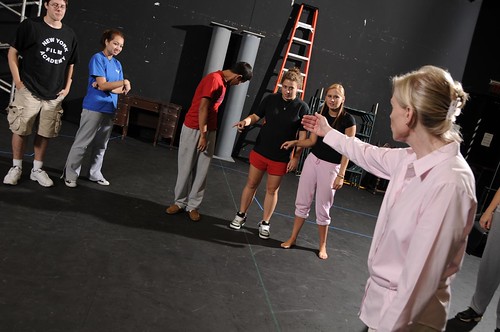I have always found it strange that the education system separates arts and sciences so rigidly when there is so much that one can give to the other. If science is about learning how mechanisms operate, then the arts is about how to employ those mechanisms to create particular effects.
One area (among others) where the arts have a lot to offer social science is the world of theatre. Drama creates situations where people must work closely together within a limited and controlled space to communicate human interactions and intensity of emotion. It means actors are in a unique position to experience reactions and feelings that highlight the presence of mechanisms of behaviour that go unnoticed or unrecognised in everyday life.
I am interested in how modern social situations can produce problematic responses in people because humans are evolved adaptations to a hunter gatherer lifestyle. Our ancestors would have lived in small tribal bands where everyone knew each other and would have been in constant social contact. But in modern life we are surrounded by strangers. A person approaching you as you walk along the street may provoke a whole mixture of sensations - fear, recognition, desire to greet, desire to avoid etc. These are all sensations that actors explore in the course of rehearsing and performing.
In the world of acting it is a well known fact that approaching someone produces sensations or even impulses that the actor must learn to use and control on stage. The closer one actor moves towards another actor the greater is their involvement as the visual reference to the surrounding environment decreases. In other words, the other person dominates the visual field and attention becomes focused on them and not the wider picture. Certain feelings come into play now, depending on whether the other person is friend, foe or stranger - love, anger, fear etc. So it appears that humans have evolved to experience strong physical reactions at crucial points of distance.
According to Clive Barker's Theatre Games, crucial distances are at 11 meters, 4.5 meters and 1.8 meters respectively. At each distance point there is a transition that moves through certain stages and which the actor experiences as critical moments of decision. Barker notes that at each transition point the "body re-coordinates slightly and this causes breaks and changes in rhythm, faltering steps and often a missed beat in the rhythm of walking." In his own case Barker says he experiences, "sudden tensions and relaxations between the shoulder blades" as he crosses each of the three transition points. Two points to add here are that (1) eye contact must be maintained during the approach and (2) these sensations are only experienced if the approaching person blocks out the surrounding visual field - but they are not experienced if 180 degree vision (or a balance between the world and the other) is maintained.
Barker calls these transition points degrees of involvement and the closer we come towards another person the greater our involvement or expectation of involvement becomes. This means the body and mind must prepare itself for action and engagement - whether that be fight or flight, acknowledge or ignore etc.
In a separate activity Barker asked his acting students to approach a partner but to do so quickly and if they felt their safety threatened to move to the right. He found that most of his students broke to the right at a distance of 4.5 meters (5 yards) from the partner. There was also some resistance at 11 meters (12 yards) too, but this was easily overcome. This activity reveals there is a distance at which hostility and fear of violence begins and it is just before the regular distance of social interaction (1.8 meters or 2 yards) is entered.
Knowing about these distances is important for actors who must work in close proximity to others, often on tiny stages, but at the same time seek detachment, e.g. Othello. But knowing about these distances is equally important for a psychologist, and especially in relation to displacement behaviour. If we know there is a transition point at which flight versus fight behaviour can become most activated, then we can limit a person's natural response and see what other behaviour emerges when we do this. Film directors do this all time to their audiences - a horror film puts us in a situation of imagined danger but does not give us a way out and forces us to go through transition points we might otherwise not choose to experience. Self-directed behaviour, such as nail biting or displacement gaze averting may occur where an audience member is neither able to entirely avoid the scary action on screen nor confront it bravely either.
For me this sort of information is crucial. In family life and social life there are many situations where people are living in close proximity with each other. This inevitably means that transition points will be felt. I believe that self-directed behaviours may emerge when close confined proximity produces sensations that cannot be expressed or acted upon and must be repressed or where impulses produce conflict with one another. This is an area that I would love to research - it would seem the arts knows certain things that the social sciences need to catch up with!
Reference:
Barker, Clive (1977) Theatre Games (Eyre Methuen London) pp.123-4

No comments:
Post a Comment
Please leave your comment below: